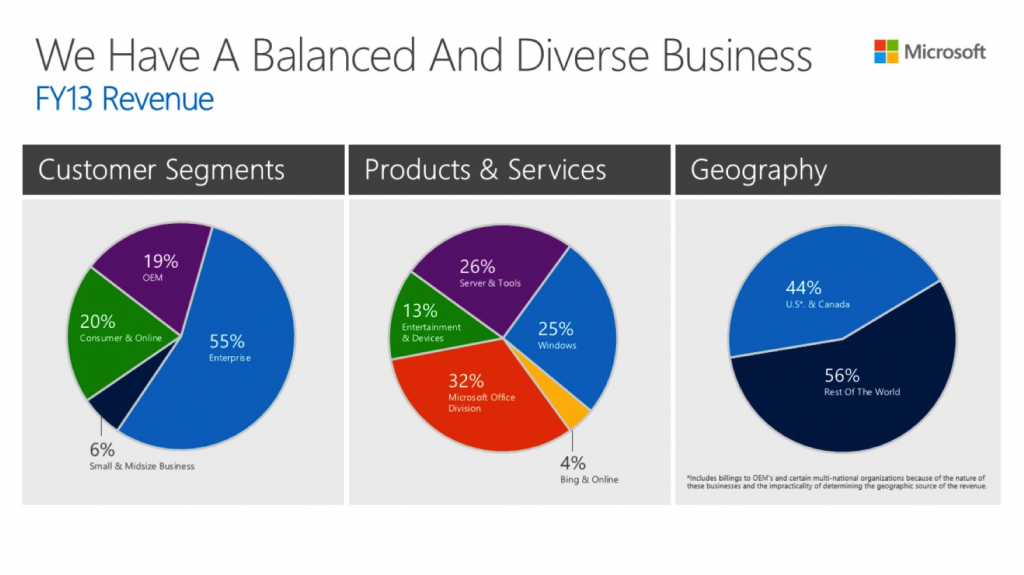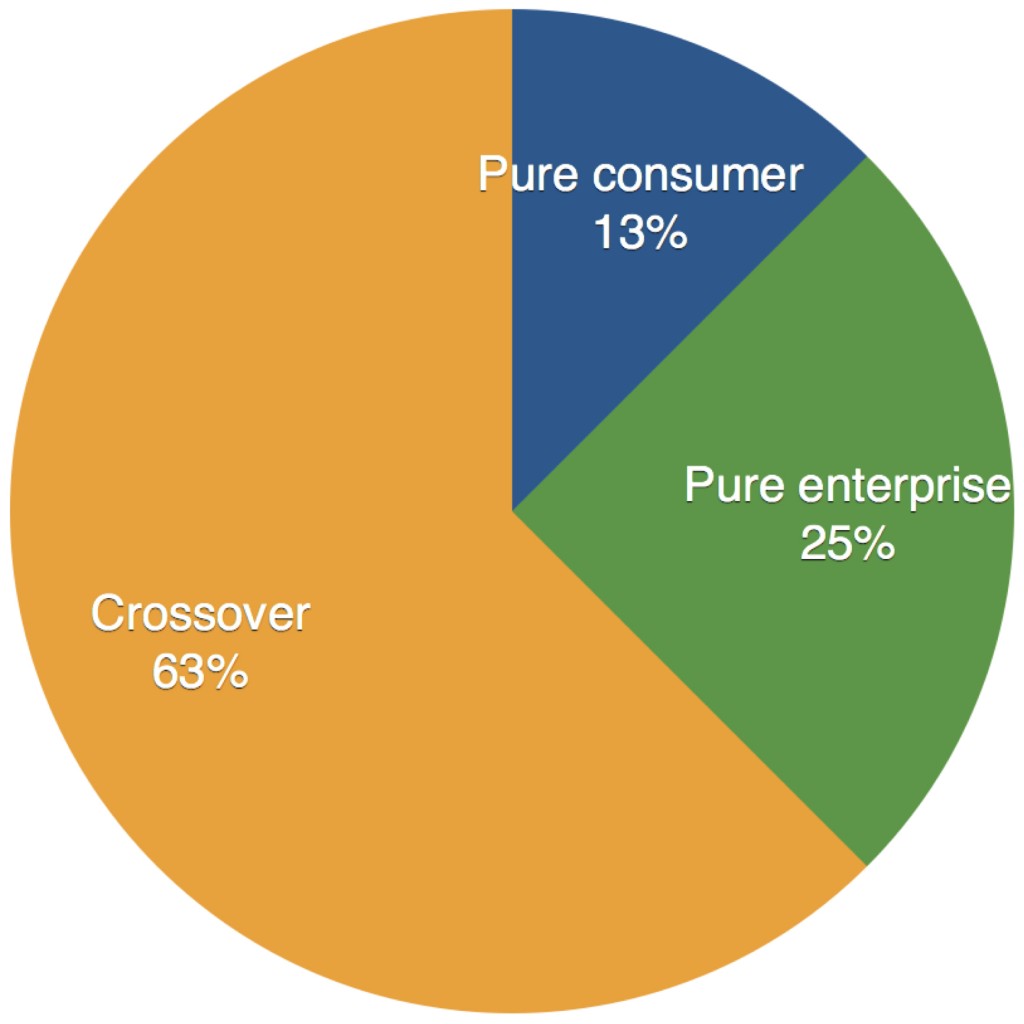At the time Steve Ballmer’s retirement was announced, there were calls for Microsoft to be split up into two businesses, serving consumers and enterprises respectively. I believed then, and believe even more strongly now, that this is fundamentally flawed thinking, and the reason is that Microsoft’s consumer and enterprise businesses are deeply intertwined, to a great extent because Microsoft has wanted them to be.
Below is a slide from Microsoft’s 2013 Financial Analyst Day, which is intended to illustrate (in the diagram on the left) Microsoft’s three customer segments:
The reality is that, while Microsoft does serve three audiences, they’re not the ones it shows in that chart, mostly because OEMs aren’t really customers, but channels to reaching either consumers or businesses. In reality, they are:
- Consumers
- Generic enterprise employees
- Specialized enterprise employees
The first two groups are actually very similar – arguably just the same people in two different facets of their lives – and use very much the same products, mostly Windows and the Office suite. The third group, though, uses a different set of products, namely Microsoft’s other enterprise tools such as Windows Server, Azure, the SQL products, Dynamics and so on. It’s this third group of users and the products that serve them that can uniquely be described as enterprise only. It is the one part that you might feasibly tease out from the rest of Microsoft, and it comprises what the company has historically reported as its Server and Tools business, which generates annual revenues of around $20 billion (out of about $80 billion in total revenue). It would then become one of the larger enterprise software companies in its own right along the lines of an Oracle or SAP.
On the consumer side there’s also a much smaller chunk that’s exclusively consumer, which is the Xbox console and related content business (including Xbox games but also Microsoft’s music and video services). This bit is worth around $7-10 billion a year, though it’s pretty cyclical with a bike spike in the holiday quarter and longer term peaks and troughs driven by console lifecycles.
The challenge, though, is that much of the rest of the company is made up of products which are used by both consumers and businesses, notably Windows itself and the Office suite, which account for about 60% of revenues but 95% of profits. This is the core of Microsoft and it would be essentially impossible (and meaningless) to separate the two. Even though there are technically enterprise and consumer versions of these products, they share a code base and much else besides, and many individuals actually use them across both personal and enterprise domains, something which will only increase as BYOD continues to grow.
Looking at Microsoft’s revenue overall, then, there’s about $20 billion in pure enterprise revenue, about $10 billion in pure consumer revenue, and another $45-50 billion in crossover revenue. The chart below illustrates this breakdown.
With this in mind, it’s clear that Microsoft’s business cannot simply be split into enterprise and consumer. At a stretch, one could feasibly put all of Windows and Office on the enterprise side, but that would mean essentially keeping most of Microsoft intact, while separating out the piece that essentially makes no money as a standalone Xbox business.
But more importantly, even then the consumer and enterprise services are so intertwined that there would have to be lots of cross-charging and cross-licensing between the two businesses. Where would Skype sit? As a product used by millions of consumers it might logically sit on the consumer side, but as an increasingly integrated feature of Microsoft’s unified communications platform it needs to exist on the enterprise side too.
What to do with Windows Phone? There’s clearly an enterprise role for these devices, and there’s also increasingly right integration between the desktop and mobile versions of Windows and Office. But at the same time, the key to creating consumer appeal for Windows Phone devices is bringing together the different parts of the consumer digital lifestyle. That means integrating Xbox games, music, video and other Microsoft consumer services into Windows Phone. How would Microsoft manage this complex interdependence?
The point is that Microsoft wants – and needs – to drive integration between its various products, to increase the value of the different parts of its platform and to increase stickiness for the whole. This means integration between devices, software and services, but it also means crossover between consumer and enterprise, something Microsoft needs to do more rather than less of.
This is not to say that all is hunky dory at Microsoft. It’s not. The key challenges include:
- That huge chunk of revenues and especially profits that comes from software licensing, in a world where Google and now increasingly Apple are teaching consumers and enterprises that they shouldn’t have to pay for operating systems or productivity software.
- Microsoft still sees consumer services as a means to an end, rather than an end in itself 1, which causes two related problems: you can never serve consumers well when you don’t see them as worth serving in their own right, and you’re always trying to force them into behavior that makes sense for your business but not for them. Jeff Bezos at Amazon likes to talk about aligning consumers’ interests with those of Amazon, and Microsoft is arguably doing the opposite.
- Although Microsoft has many of the pieces which are critical to success in the consumer market, it’s done a terrible job for the most part of bringing them together in a truly integrated fashion. This is most notable in the content and communications domains, which are critical to overall success.
- Microsoft badly needs to deal with its brand and the associations it has in consumers’ minds. Microsoft for most consumers represents a company whose products they are essentially forced to use either because of a corporate environment or because of their nature as de facto standards. I’d argue almost no consumers would positively seek our Microsoft products in their personal lives if given alternatives. The success of the Xbox is an example of what can be achieved when the Microsoft and Windows brands are subsumed 2.
I’ll tackle each of these challenges in a future post, but the key point here is that Microsoft’s consumer and enterprise businesses are deeply and intentionally intertwined and it makes no sense to rue to break the two up artificially. Rather, Microsoft needs to install leaders (likely a CEO and one or two key deputies) who can run both the consumer and enterprise businesses effectively, side by side, while embracing that integration in a way that aligns Microsoft’s interests with those of consumers.
Notes:
- “But one of the things that we have really kind of taken note of from a profitability perspective: we will be led by our work in the enterprise services and devices. We think that the greatest profit growth, it doesn’t mean the greatest innovation; it doesn’t mean we won’t do “consumer services,” because they are important. They’re important to the customer. They’re a path to enterprise services. They’re a path to device success. But, in some senses we will lead as we go to market and we will certainly lead in terms of how we hope to generate profit, through devices and through enterprise services.” – Steve Ballmer at Microsoft’s 2013 financial analyst day. ↩
- Try to find any references to Microsoft or Windows above the colophon on the Xbox site. ↩


Pingback: Thoughts on Microsoft’s earnings for Q1 2014 | Beyond Devices()